
It was yet another classic battle between the fiercest rivals of Europe as Germany left it late to edge past the Netherlands in a five-goal thriller. A huge sigh of relief for Joachim Low who has been under the scanner ever since the 2018 World Cup disaster.
It looks like he has finally found the final piece of the jigsaw as he was at his tactical best that he needed to be in order to reign supreme against the in-form Netherlands. After going 0-2 up within the first half, thanks to Leroy Sane & Serge Gnabry, the Germans failed to hold onto the advantage as Memphis Depay’s heroics once again came to the Netherlands’ rescue in the form of a goal and an assist to make it 2-2.
However, German left-back Nico Schulz had other plans on how to end the game as his gamble to run into the box paid off with a neat finish to grab the winner.
It was an eventful evening with multiple players making a name and announcing themselves into the big stage, however, the tactical battle between the two coaches cannot be ignored. When the world thought that the back-three experiments of Low are finally over, the gaffer surprised Koeman with yet another back-three setup.
On the other hand, Koeman had a surprise of his own by benching the most in-form Dutch youngster Steven Bergwijn to start both Ryan Babel & Quincy Promes. Both teams kept swapping with each other for the driver's seat and in the end, the Die Mannschaft emerged supreme.
There were a number of essential factors that a budding coach could grab his notepad and make note of from the nerve-wracking Euro Qualifier. Let’s take a look at where the game was won or lost from a tactical perspective:
#3 Low’s experiment with the 3-4-1-2 reaped rewards
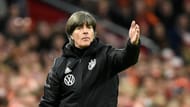
It was clear that Joachim Low had done his homework before setting his side up against the in-form Dutch. Due credit needs to be given to the under-fire manager for having gone ahead with his experimental 3-4-1-2 and being tactically spot-on when it mattered the most.
Opting for a back-three constituted by Matthias Ginter, Niklas Sule & Antonio Rudiger allowed the full-backs, Thilo Kehrer & Nico Schulz, to push higher up much more freely. Another advantage was that the three centre-backs spread wide during build-up and made it difficult for the Dutch attackers to press as there was a lot of areas to cover.

The 3-4-1-2 setup also allowed Germany to have numerous players unmarked and they used this to the maximum advantage to outnumber the Oranje. A major reason they were able to create such a numerical superiority was because of the movement of the players.
German forwards Leroy Sane & Leo Goretzka didn’t remain central and rather occupied wider half-spaces to keep the Netherlands full-backs pinned. This meant that the Dutch wingers had to track-back in order to not let the German full-backs completely free.
With all of Netherlands’ wide men occupied, there was no one to close down when one of the German centre-backs (either Ginter or Rudiger) pushed higher up to make themselves available as a passing option.

Adding fuel to the fire was Serge Gnabry’s dynamic movement from the number 10 position. The Bayern Munich attacker didn’t give a moment’s rest to Koeman’s men as he was the liveliest attacker on the pitch during the first half.
At times, he dropped deeper into the midfield alongside Toni Kroos and Joshua Kimmich to help build-up play but he also made threatening runs behind the Dutch back-four to receive defence-splitting through balls.
Owing to this free role, there was confusion among the Netherlands midfielders and defenders as no one was ever sure about whose responsibility was it to handle him. During the first half, Gnabry was the player with second most number of touches on the ball for Germany with 41, with only Kimmich having more touches with 42.
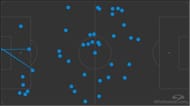
#2 Germans paralyze the Dutch in the midfield
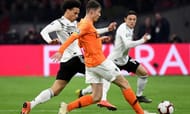
It took a real masterstroke from Low to succeed in halting the Oranje midfield which has been nothing less than dominant ever since the trio of De Jong, Wijnaldum & De Roon joined forces.
Without a doubt, it is a herculean task to keep at bay, a team like the Netherlands which boasts numerous players who are exquisite on the ball. But it made complete sense for Low’s men that the main objective off-the-ball was to keep the midfield trio’s influence as minimal as possible.
The reason is simple; the entirety of attacking gameplay depends largely on the players who form the spine of the Netherlands. By spine, one would refer to players namely van Dijk, De Ligt, De Jong, Wijnaldum & Depay. If the verticality that connects these players together is cut-off then there are barely any alternate options for creativity.
So how did the Germans manage to pull this off? The first step was to ensure that the de Jong does not get into comfortable positions in the middle third from where he can progress the play into the final third.
So the front-three of Sane, Gnabry & Goretzka along with midfielders Kroos & Kimmich formed a compact pentagon-shaped pressing trap in the middle. If any Dutch player entered in between the five, there would be aggressive pressing to force him into an error or play the ball backwards.

The shape made it very difficult for the Oranje to penetrate through the middle and connect with Depay or Wijnaldum, forcing them out-wide to the full backs. Once either of full backs received the ball, they were immediately pressed by the corresponding German full back with support from one of the midfielders Kroos or Kimmich who would cut off nearby passing options.
There is a simple reason why it is easier to win the ball back closer to the touchline than from any other area on the pitch. When the opponent is on the ball close to the touchline, by default he has lesser space to move and the only direction he can move into is away from the touchline.
Similarly, even the passing options become limited for the same reason. Contrary to a situation where the player is on the ball in the middle of the pitch, he has 360 degrees to move into or to find a passing option.
In the words of Pep Guardiola,
“Touchline is the best defender in the world.”
Low’s men brilliantly misguided the Netherlands into playing the ball to their full back, applied high pressure and won the ball on numerous occasions. The Oranje were dispossessed about 17 times in the first half out of which 14 times were from the wide areas.
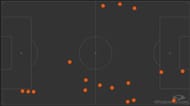
#1 Schulz schools Dumfries
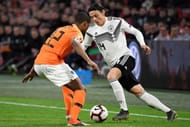
It was a high-intense battle on the flank between Denzel Dumfries and Nico Schulz that quite literally determined the result of the game. It may seem harsh on the Netherlands right-back but the fact remains that all of Germany’s goals originated from his side of the Dutch defence and Schulz’s goal & assist is a good enough proof to it.
Dumfries is not the easiest defenders to compete against in duels, be it one-on-one or aerially but yesterday was a night to forget for the PSV man as he was constantly outplayed tactically as well as physically by Schulz who has probably had his best ever game for the Die Mannschaft since his debut last year.

The first goal was preceded by a move started by Kroos playing Schulz through into open space when Dumfries was not really out of position. But the mere burst of pace by Schulz was surprisingly enough for the left back to gain a couple of yards against Dumfries before whipping in a teasing cross to Sane who put the Germans ahead with a sublime finish.
An unfortunate slip from de Ligt made things much easier for Sane who otherwise might have had the hurdle of beating De Ligt before taking a shot. However one of the most important aspects of Dumfries’ game is his physical abilities.
It is a totally different scenario if he was tracking back from attack and chasing a player who started ahead of him. But if he was beaten for sheer pace by the only player he had to mark despite being in the right position, then it is definitely something to worry about for him.
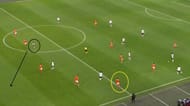
The second goal was an absolute humdinger from Gnabry and to say that it could be one of those nominated for the FIFA Puskas award later this year would be no exaggeration. Kudos to the moment of individual brilliance but how did he pull van Dijk out of position and cut in from the flank?
Well with Dumfries pulled out of position by Schulz, there was a huge gap on the wing that Gnabry was smart enough to spot and run into. Gnabry made the run, the ball played to him was perfect and within a matter of seconds, it was 0-2 to Germany.
There could be another angle to this goal that after the first goal, Dumfries’ attempt to overly concentrate on Schulz and follow him allowed the latter to pull him up the pitch. But it was still surprising to see the kind of gap that was constantly being created on the right side of the Oranje defence throughout the first half.

The third goal was definitely the most heart-breaking one of the lot for the Netherlands as they had made their way back into the game and when it looked like they were the side who were likely to grab the winner, the Germans stole all three points in the dying moments of the game.
Again, Dumfries does not have anyone to blame but his own self. When it finally looked like Schulz was being contained, the Dutch right-back switched off for a couple of seconds to allow the German to run into the centre and guide it past Cillessen.
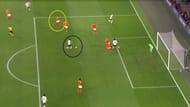
With De Ligt on Reus, De Roon on Gundogan and Dumfries on Schulz, had each player kept his eye on his man, it was certainly an avoidable goal. De Ligt’s reaction to Dumfries after the winning goal summarized the forgetful evening for the latter.
It only goes on to show how a single duel between 2 players could turn the game around its head and this is all the more the reason why it's absolutely essential for coaches to pay attention to every little detail. All said and done, there is no denying that the two arch-rivals gave the fans a game to remember for a long while.
